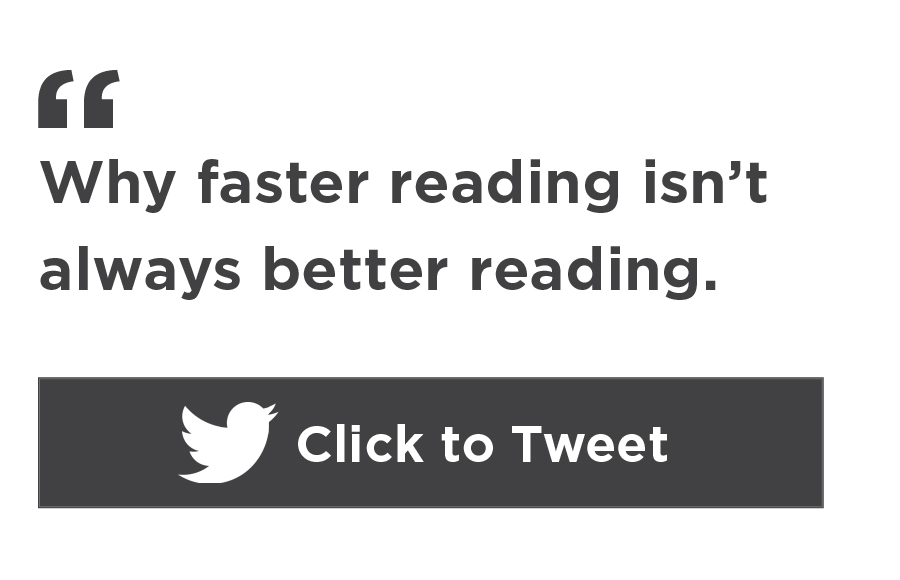Last night, I was listening to an audiobook and thought to myself, “Now that’s some fluent reading—and so darned accurate, too!” OK, I just lied. I would never think that, because there’s no such thing as an audiobook with poor fluency or weak word accuracy. When we’re listening for meaning, we insist on excellence—100%, please—on both accuracy and on that smooth, fluent delivery. In literacy circles, that’s called prosody.
So if that’s what reading sounds like for adults, how exactly are kids going to get there? What does it mean to become more fluent, and how does that change over time?
From automaticity to prosody
For our earliest readers, we want to see kids developing some automatic word recognition. As they grow in this, we can watch that growth in both reading rate and reading accuracy. While those words correct per minute (WCPM) are growing, we are witnessing gains in automaticity. That’s exciting stuff. Automaticity means that kids aren’t spending all their brainpower decoding each word, so there’s some power available for making meaning.
But then what? Eventually, they hit a rate that is roughly good enough. We certainly don’t need kids who talk slowly to read faster than they talk. So at some point, we start to be interested in something else, eventually even more than how fast they read: prosody. Prosodic reading sounds smooth, expressive, and full of meaning. When you hear a student reading with good prosody, you can hear that they understand the text.
How prosody helps us comprehend
It turns out that prosody is pretty interesting. First, it doesn’t just happen in oral reading; when we read silently, we apply the same kinds of tools. We mentally bracket phrases that hang together. We stress particular words more within those phrases. We pause at commas, and we pause at periods. This is so that we can integrate the words into an ongoing model of comprehension. We’re monitoring our understanding all the while.
Many important reads […] call for a little more time with each phrase, each sentence, and each paragraph. They call us to repeat, to try that one more time with feeling, to work harder to integrate more new understandings.
Sometimes, we lean into prosody as a strategy. Think of yourself reading along, realizing you missed the meaning of what you just read, and then backing up. You probably try it again with feeling. Kids who can read a text out loud with prosody are letting you spy on something that actually helps them make meaning.
Prosody is something we want kids to always apply. They don’t need to overdo it unless they are on the stage, but they need to be able to apply very solid prosody skills—even silently—to maximize comprehension. Being able to reach 100% in prosody is like being at 100% in accuracy. We always want that, across all kinds of texts and for all kinds of purposes.
How we tune rate for comprehension
Rate, on the other hand, is not like that. We care about automaticity, and we want kids reaching a threshold that demonstrates really solid automatic word recognition. But we don’t always want 100% of a kid’s top reading speed. After a point, faster reading is not better reading. In fact, better reading is often consciously slower, when a student is tuning that rate to the comprehension demands at hand.
Last night, I realized that I needed to dial back the speed a bit on that audiobook. I often listen at around 1.5 times the regular speed, but that’s because I often read plotty page-turners. The rate I had it set at was not going to work for this current book. Like many readers these days, I’m picking up tougher books, thought-provoking ones that help me go deeper with understanding the structures of inequity.
Many important reads are not 1.5-times-regular-speed books. They call for a little more time with each phrase, each sentence, and each paragraph. They call us to repeat, to try that one more time with feeling, to work harder to integrate more new understandings.
Prosodic reading sounds smooth, expressive, and full of meaning. When you hear a student reading with good prosody, you can hear that they understand the text.
Students, literacy, and big thoughts
Our students in the middle grades and the secondary grades are grappling with a lot these days. Like many of us, our students need to make sense of systemic racism and our public health crisis. At the same time, their experiences out in the world are much more constrained by pandemic precautions. Our kids deserve the superpower of broadening their worlds and deepening their understandings another way: through reading. They deserve tools for reaching further and deeper, for getting into consequential ideas.
We can teach students about pushing prosody to 100%, about tuning rate so that we have time to process big thoughts. Let’s empower them to read deeply from Nikole Hannah-Jones and The 1619 Project. Let’s set them up to really engage with Dr. King’s Letter from a Birmingham Jail.
Let’s keep our eyes on the right target: What we want for our next generation is not faster and faster reading. What we want for them is a literacy of liberation, equity, and power.









